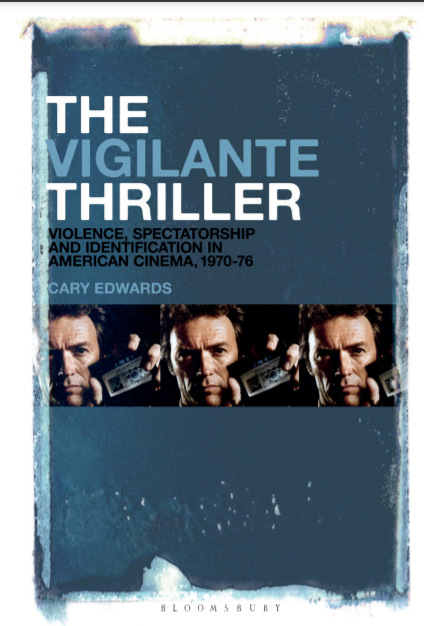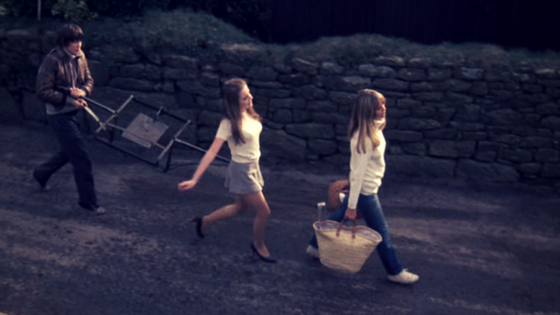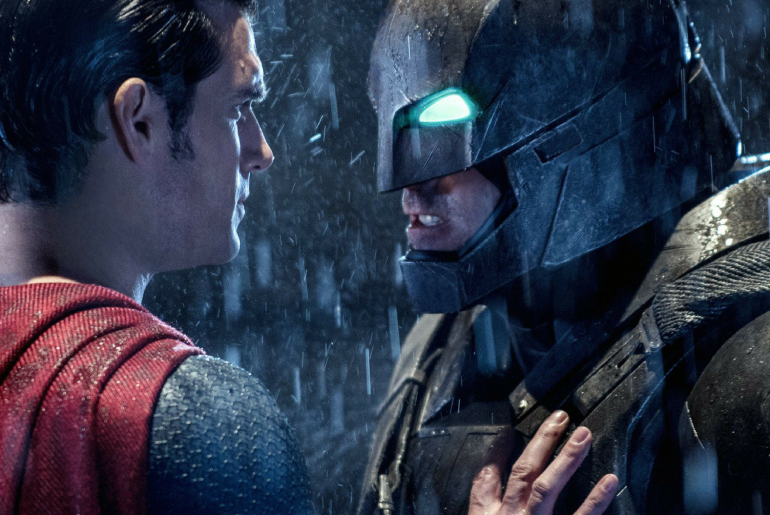This article was previously published on Bright Lights Film Journal.
Since original publication the excellent Wonder Woman (Patty Jenkins) was released, embodying the opposite of Rand’s ideas. It has now made more money than Batman v Superman despite costing about $150 million less.
In 2016, Zack Snyder’s Batman v Superman: Dawn of Justice staggered its way to over $800 million at the global box office. For many films this would have been a considerable success, but for one with such high expectations – that cost in excess of $250 million to produce and market, and was supposed to be the tent pole off which Warner Bros would hang its DC extended universe – it was a disappointment (especially when rival superhero bout Captain America: Civil War powered past the billion mark). Alongside the perceived failings of Suicide Squad, changes occurred at the top of Warners, with Geoff Johns becoming the new creative lead tasked with adding more levity to the DC universe. But I would argue that Batman v Superman’s shortcomings, and those of its 2013 prequel Man of Steel, have more to do with the philosophical beliefs of their director, Zack Snyder, than simply with tone.
Among the many negative reviews (the film currently has a score of 27% on Rotten Tomatoes) and fan reactions, a noted theme developed: that the film, and the filmmakers, were clearly more interested in Batman than Superman (hence his first billing) and that Batman v Superman failed to capture the essence of the Superman character and mythology built up since his debut in Action Comics #1 in 1938. Much of the negative reaction focused on the generally glum tone taken with a character who had previously been seen (particularly in the Christopher Reeve incarnation) as the embodiment of light and hope. Similar issues had been taken with Man of Steel, especially in the sequence where Superman, as Clark Kent, allowed his adopted father to die in a tornado. How could the filmmakers so misunderstand such an American icon?
In March 2016, while finishing work on Batman v Superman, Snyder stated in a profile in The Hollywood Reporter that:
I have been working on The Fountainhead. I’ve always felt like TheFountainhead was such a thesis on the creative process and what it is to create something. Warner Bros. owns [Ayn Rand’s] script and I’ve just been working on that a little bit.
This quote reveals Snyder’s interest in Rand and Objectivism and points to a key reason why his version of Superman fails to live up to the character’s nearly 80 years of history. Indeed, Rand’s ideas have become increasingly popular since the 1980s and, if the Atlas Society is to be believed, well liked in Hollywood. And this makes sense, as on the surface Rand advocates a self-made hero, one who uses his talents for his own gain. For Rand, this “rational selfishness” is the key to improving society, and on the surface Superman might appear to be a reasonable simulacrum of the Randian Hero; strong muscular types, who are handsome, well-built, and possess an iron will. But if we delve into Superman’s conception, we can see that he really stands as Objectivism’s antithesis.
Superman’s Left-Wing Origins
Created in the 1930s by two young Jewish high school students, Jerry Siegel and Joe Shuster, Superman went through several iterations before they settled on the version that would catch fire with the public and start a superhero boom. These early stories may come as a surprise for those with only a casual knowledge of the Man of Steel’s history: he tackled gangsters, slum landlords, and profiteers rather than mad scientists or alien threats (as detailed by Les Daniels, 1998). Siegel and Shuster had taken their Superman ideal and put him to work as an often violent hero, not averse to killing the odd wife beater. As sales grew, the publisher asked Siegel “to cut out the guns and knives and cut back on social crusading” (Larry Tye, 2012), but the essence of Superman was set. Drawing inspiration from film star Douglas Fairbanks Sr. (in his portrayals of Robin Hood and Zorro), Siegel and Shuster deigned that Superman would use his powers for the good of all, while his alter ego, journalist Clark Kent (an embodiment of the reality of the creators’ lives), struggled to get the story or the girl. As wish fulfilment Superman is revealing – rather than using his unlimited powers for self-gain, Siegel and Schuster wrote Superman as selfless, one who instinctively uses his powers for others. It’s something that 1978’s Superman (Richard Donner) was imbued with, developed in the character’s Kansas upbringing (a sort of “gee whiz” nostalgia for 1950s morals) and the screenplay’s treatment of the character as a Christ figure. In a message left for him to discover, Superman’s Kryptonian father Kal-El (Marlon Brando) intones,
They can be a great people, Kal-El, they wish to be. They only lack the light to show the way. For this reason above all, their capacity for good, I have sent them you… my only son.
Biblical allusions aside (and there are many more in the film), the essence of Superman was captured; someone who does good, because it is good to do so. Rand’s conception of a hero, and indeed of good, is rather different.
Rand’s Hero
In Atlas Shrugged, the philosopher character Ragnar Danneskjöld pronounces:
Robin Hood … He was the man who robbed the rich and gave to the poor. Well, I’m the man who robs the poor and gives to the rich – or, to be exact, the man who robs the thieving poor and gives back to the productive rich.
Rand’s philosophy is based on the conception that being selfish is a moral good, and that the sole aim of life is to pursue happiness through “productive achievement” (quoted by Joseph Breslin). In this conception, a folk hero like Robin Hood is punishing those who produce, to feed “moochers” and “looters.” The looters are the government types who take from the productive to give to the unproductive moochers, and all are keeping great men back.So what of society’s poor and disadvantaged? Well, it’s their fault, and you owe them nothing, according to Rand. In Atlas Shrugged, the hero John Galt outlines this clearly,
Do you ask what moral obligation I owe to my fellow men? None – except the obligation I owe to myself, to material objects and to all of existence: rationality.
In Rand’s conception the poor and the needy are parasites, living off the talent and industry of others. As she explained:
The Objectivist ethics holds that human good does not require human sacrifices and cannot be achieved by the sacrifice of anyone to anyone (www.aynrand.org).
No wonder Superman looks so glum rescuing flood victims in Batman v Superman – they’re just moochers who should have worked harder to provide a better shelter for themselves.The Randian hero is one who concentrates on himself, pursues his goals for their own worth without thought or sense of society. In Rand’s view, happiness is achieved through selfishness, through taking care of the individual’s needs and not caving in to moralities that suggest that self-sacrifice and sharing can lead to happiness. In this conception of the universe Superman cannot be happy in his rescuing of the innocent, only in his time with Lois in which he displays and pursues his own desires. Happiness comes partly “by treating others as individuals, trading value for value” (www.aynrand.org) – thus relations with others are predicated on trade, on exchange. What have the helpless and needy got to give Superman? If Clark Kent had been adopted by Rand instead of Ma and Pa Kent, what would have stopped him from becoming a tyrannical overlord? Much of the reason for the continued popularity of Christopher Reeve’s portrayal was the commitment he gave to the character irrespective of whether he was saving Lois from falling to her death or rescuing a kitten for a little girl. For Rand the little girl is a moocher, Lane only worth rescuing if Superman sees in her his self-interest (as in, if he won’t get laid, she can hit the pavement). Applying an Objectivist view point to Superman results in the muddled character Batman v Superman presents.
Superman in Batman v Superman
The failings of Snyder’s Superman can be summed up in a conversation the character has with his Earth mother Martha Kent during Batman v Superman. In the exchange, Martha explains to Superman, “You don’t owe this world a thing. You never did.” This is the world that nourishes him (literally, as the yellow sun generates his power) and provided loving parents, but this sequence suggests he doesn’t have to pay heed to that. In Man of Steel, the death of Jonathan Kent, during a tornado, illustrates this viewpoint. Rather than reveal his powers to the world, Clark lets him die, and the film suggests Jonathan is all right with that. Personal priorities triumph over another’s need. A key element of Batman v Superman is the re-creation of the popular “Death of Superman” storyline from the 1990s comics, but the differences between the film and the original are instructive. By removing the battle with Doomsday to outside Metropolis and making Doomsday a creation of Kryptonian DNA and technology, Snyder removes the social good of Superman’s sacrifice in the fight, but also the connection to the extended family generated over decades in the comic book. Rather than a sacrifice for the lives of others, his death becomes a moment of sacrifice for himself, a personal atonement rather than an act of social good. In the comic, his death is viewed by close friends, other heroes, and strangers. In the film, there is Lois Lane (his lover), Batman (who 10 minutes earlier was trying to kill him), and Wonder Woman (a stranger). The contrived pieta illustrates just how far Snyder misunderstands Superman by redrawing him along Rand’s selfish lines. This selfish self-sacrifice misses the essence of drama that exists in a character who can do almost everything. It is in the choice (of how, when, and who) to help that Superman’s character fascinates. This dramatic axis is underpinned by the character of Clark Kent, his humanity motivating Superman’s choices. There is no self-interested reason for Superman to retain the Clark Kent persona after he is revealed to the world (is it any wonder, then, that Clark Kent is such a small part of Batman v Superman and is killed off)? Superman is tethered to the world by his/Clark’s extended family, something Snyder was happy to partially dispense with in the killing of “Superman’s Pal” Jimmy Olsen, something the director described as “fun” (www.independent.co.uk).
Batman v Superman
Despite the overall negative tone of the critical reaction to Batman v Superman, some praise was given for Ben Affleck’s Batman. How can a film that misunderstands one hero get the other right? The secret may be in comic author Frank Miller’s liking for Rand (Miller authored The Dark Knight Returns on which Batman v Superman is partially based). The Atlas Society’s website quotes Miller,
I was drawn again and again to the ideas presented by Ayn Rand in her 1957 novel Atlas Shrugged. Eschewing the easy and much-used totalitarian menace made popular by George Orwell, Rand focused instead on issues of competence and incompetence, courage and cowardice, and took the fate of humanity out of the hands of a convenient “Big Brother” and placed it in the hands of individuals with individual strengths and individual choices made for good or evil. I gratefully and humbly acknowledge the creative debt.
Batman works well as a Randian hero – the rich individual, working out his personal neuroses by beating up the moochers and looters (interestingly he has no moochers in his own house – dependents Alfred, Robin, et al. have to work for their keep). In Miller’s The Dark Knight Returns, a retired, older Bruce Wayne returns to being Batman not because he wants to help the city, rather because his personal obsession is inescapable. For Miller, Superman becomes a government stooge, his patriotism and commitment to good tethering him to the looting politicians.By basing much of Batman v Superman on Miller’s work, and with a fan of Rand at the helm, Superman gets a raw deal. Gone is the nobility of helping those who can’t help themselves. What is left is an image of Superman, but one that is hollow and missing its essence. This year a Justice League movie is being released (also directed by Snyder), with a Man of Steel sequel planned. Only ditching Rand’s quasi-philosophy can get Superman back on track and revive the character.
Works Cited
Bidinotto, Robert James. “Celebrity Rand Fans.” The Atlas Society. https://atlassociety.org/commentary/commentary-blog/4598-celebrity-rand-fans
Breslin, Joseph. “Ayn Rand: The Good, Bad & Obscene or Why Objectivism Is Flawed.” The Washington Times. http://www.washingtontimes.com/news/2014/dec/31/ayn-rand-good-bad-obscene-or-why-objectivism-flawe/
Daniels, Les. Superman: The Complete History – The Life and Times of the Man of Steel.Chronicle Books, 1998.
Miller, Frank. The Dark Knight Returns. DC Comics, 2006.
Rand, Ayn. Atlas Shrugged. Penguin Classics, 2007.
Shepherd, Jack. “Batman v Superman Director Zack Snyder Explains Why He Killed Off Jimmy Olsen.” The Independent. http://www.independent.co.uk/arts-entertainment/films/news/batman-v-superman-zack-snyder-explains-why-he-killed-off-jimmy-olsen-a6954956.html
Siegel, Tatiana. “‘Batman v. Superman’: Married Creative Duo on That R-Rated DVD, Plans for DC Superhero Universe.” The Hollywood Reporter. http://www.hollywoodreporter.com/news/batman-v-superman-married-creative-874799
Tye, Larry. Superman: The High-Flying History of America’s Most Enduring Hero. Random House New York, 2012.“Introduction to Objectivism.” https://www.aynrand.org/ideas/overview“Selfishness.” https://campus.aynrand.org/lexicon/selfishnesswww.boxofficemojo.com








